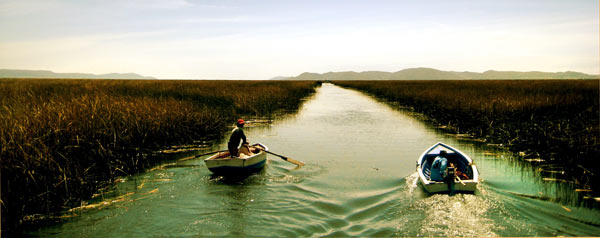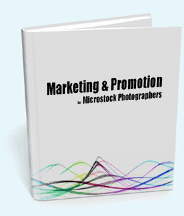Five ideas to increase microstock downloads. While the beginners deal with taking better photos and rejections for noise and artifacts, the serious microstock contributor should have their eyes firmly set on optimizing what they do best and making the most out of the images they create.

Send Buyers
Sending potential visitors to an image of yours on a microstock site is a great way to make sales and also to earn extra affiliate revenue. Getting those potential buyers is the difficult part: here are a few pointers.
Your Website or Blog - with more and more of us running some sort of website or blog, even just a flickr or other website site profile, placing a link to allow people to view your portfolio at an agency is something all of us should be doing. Even if you want to direct buyers to a lightbox of your photos that is not part of a referral marketing program it will still increase the exposure of your work. Anything you can do to make your work more accessible to buy is a good thing, more about microstock affiliate marketing.
Social Networking - If you are involved heavily in a network site i.e. I you have lots of 'followers' then a few discrete messages here and there about your latest uploads or sales might lead to a few more interested parties looking at your work, but take great caution, if like me you have built a following of other photographers then tweeting about your latest images is likely to fall on deaf ears, do it too many times and people will unfollow. Look into creating or using a network aimed at buyers, not only is this a way to get a marketing message across, but also more importantly I think, it is a way to keep track of styles and trends in the design community.
Paid Ads - I don't think I would recommend this at the moment for microstock. I don't currently see a business plan in paying for traffic and sending it to your microstock images. Am I wrong? I'm sure that there are all manner of marketing methods that might work, but paid clicks is probably not one of them, the return per referral is too low to make it feasible, but that's not to say you can't investigate other solutions like link exchanges.
Showcase Your Work - I tried measuring the results of putting my images on flickr and some other photo sharing sites, with the aim of sharing them for use free of charge (you can also do this by keeping full control by reserving all rights to image use). To be honest I failed to get anything measurable from my testing, BUT it's clear to see that people do see your work when it is on these sites, most of them are not buyers so keep that in mind. Be thinking 'buyer' in the things you do on these sites for example join groups that potential buyers might also be members of. Reasons you should be on flickr.
Printed cards and flyers, istock provide (or once did provide) their exclusive members with free business cards that contain a signup code, photographers distribute these cards to designers that they meet. It depends on how many people you know and meet while out-and-about if this will be a success for you. There is no reason that you need to be an exclusive istock member, you could get cards printed yourself and include the url of your profile / a referral code to your favorite agency / or a short bit.ly style url. Cards are a handy thing to give to those people who come up and ask "what are you are taking photos of and why?" while you are working outdoors. Flyers and direct mailing - from what I hear, forget it!
Create Lightboxes, Galleries or Collections
Several of the microstock agencies allow you to create public galleries or lightboxes of similar images (make sure it's the public ones you are using, that you can share a link to). I have no hard evidence that this works, when used properly the effect is something like pinterest - a page that contains a curated collection of beautiful images that match a specific theme. Lightboxes make a great url "landing pages" to send traffic to when used to match the interests of that traffic.
Are your Descriptions working for you?
Good descriptions and titles not only allow more people to find your images, they can also persuade more people to actually click 'buy'. Even more importantly than that they allow your microstock images to be found in a search engine like google / google images. The image title of a stock photo is often used by an agency to create the "Page <Title>" on the image sales page on the website which is vital to the page's performance in search engines. Your most important descriptive keywords should be in that title, not an abstract or amusing play on words - save that for the description field. Read Titles and Descriptions that Sell for more advice on keywording and titling.
Take Great Photos and Edit to Perfection
Don't lose sight of the fact that the best way to make more sales is to have the best images to start with, without a good product you're not going anywhere. Spending just a few minutes in photoshop optimizing colors and removing 'awkward' details from photos can bring increased sales over just uploading what the camera took. Analyze what is selling, what has sold before and keep an eye open for any trends or current styles of image especially if you operate in a niche area. Choosing subjects that people want to buy will obviously earn you more downloads than taking images that few people need. You should spend some of your 'microstock time' working out which of the style of images you are able to create sell the most frequently and analyzing what's currently selling in microstock.
Focus Your Efforts
 Only spend time uploading to sites that are working for you. Be ruthless, if you are uploading to more than 10 image sites then are you sure that the lowest earners are worth the effort? Cutting out bad habits like checking email constantly are known to save time, apply this to microstock. Never log into a site just to check how many sales you have made unless you are analyzing your sales methodically. Checking how much money you earned in the last 24 hours is a complete waste of time, focus on creating new images, researching or learning new skills that will benefit your work. Invest time in using technology and services to optimize and automate parts of your workflow. Doing anything that saves you time means more time free to shoot images, more images means more sales.
Only spend time uploading to sites that are working for you. Be ruthless, if you are uploading to more than 10 image sites then are you sure that the lowest earners are worth the effort? Cutting out bad habits like checking email constantly are known to save time, apply this to microstock. Never log into a site just to check how many sales you have made unless you are analyzing your sales methodically. Checking how much money you earned in the last 24 hours is a complete waste of time, focus on creating new images, researching or learning new skills that will benefit your work. Invest time in using technology and services to optimize and automate parts of your workflow. Doing anything that saves you time means more time free to shoot images, more images means more sales.
Related Posts
More ways to Promote your stock image portfolio
Setting up your own photography blog or website



Good Advice!
LaRoach (not verified) on Wed, 2010-11-03 00:18Too involved
Steve Gibson on Wed, 2010-11-03 21:59And its very easy to do. Everyone in microstock knows not to get 'involved' with an individual image, yet it's all too easy to get 'involved' with an agency who you think will get better "if I only upload a few more images" or with a workflow you have developed "this is the way I have always done it" "this is the cheapest way". A good objective look can weed out the agencies that are not so cost effective and the find parts of your workflow that cost you more in time than the money they are perceived to save.
If an image turns out not to work you can go back and re-shoot or rework the idea or in some cases just write it off. The same way of thinking can be applied to agencies and to your workflow.
Thank you
Publio (not verified) on Fri, 2015-04-03 13:36